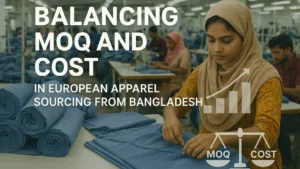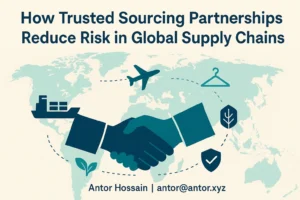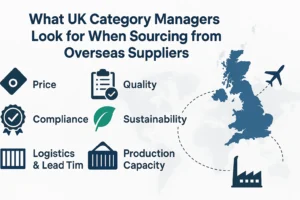By Antor Hossain
📧 antor@antor.xyz | 🌐 antor.xyz

Introduction
In the competitive landscape of European fashion retail, balancing Minimum Order Quantity (MOQ) with production costs is a critical challenge. While smaller orders offer flexibility, they often come at a higher per-unit price. Conversely, larger orders can reduce costs but increase inventory risks. This article explores how European retailers can navigate this balance, leveraging Bangladesh’s robust apparel manufacturing capabilities.
Understanding MOQ in Bangladesh’s Apparel Industry
Minimum Order Quantity (MOQ) refers to the smallest quantity of a product that a supplier is willing to produce or sell. In Bangladesh, a leading global apparel manufacturing hub, MOQs are influenced by several factors:
- Fabric Type and Dyeing Processes: Complex fabrics and dyeing techniques often require larger batches to justify setup costs.
- Garment Complexity: Intricate designs or specialized garments may necessitate higher MOQs due to specialized labor and equipment.
- Finishing Processes: Additional treatments like washing or embroidery can increase the minimum order size.
- Factory Capacity: Larger factories may have the flexibility to handle smaller orders, while smaller units might require higher MOQs to optimize production.
For instance, a typical MOQ for a basic cotton t-shirt might be around 1,000 pieces, while a specialized garment like a denim jacket could have an MOQ of 2,500 pieces.
The Cost Implications of MOQ
Ordering below the established MOQ can lead to several cost-related challenges:
- Higher Per-Unit Costs: Smaller production runs often result in increased setup times and material wastage, raising the cost per unit.
- Inefficient Use of Resources: Production lines optimized for larger batches may operate less efficiently with smaller orders.
- Increased Shipping Costs: Smaller orders may not fill containers efficiently, leading to higher per-unit shipping costs.
Case Study: A European retailer sourcing denim jackets from a Bangladeshi factory experienced a 25% increase in per-unit costs when ordering 1,000 pieces instead of the standard 2,500. The factory had to adjust its production line, leading to inefficiencies and higher costs.
Balancing MOQ and Cost: Strategies for European Retailers
European retailers can employ several strategies to balance MOQ and cost effectively:
1. Consolidate Orders Across Styles
By combining different styles or colors into a single order, retailers can meet the MOQ without overstocking any particular item. This approach allows for a diverse product range while maintaining cost efficiency.
Example: A retailer orders 500 pieces each of five different t-shirt designs, totaling 2,500 pieces, to meet the MOQ.
2. Negotiate Flexible MOQs
Engaging in open discussions with Bangladeshi suppliers about flexible MOQs can lead to mutually beneficial agreements. Suppliers may be willing to lower MOQs if they understand the retailer’s market dynamics and potential for future orders.
Example: A retailer negotiates with a supplier to reduce the MOQ from 2,500 to 1,800 pieces by agreeing to a longer lead time and committing to future orders.
3. Utilize Technology for Demand Forecasting
Advanced demand forecasting tools can help retailers predict sales more accurately, allowing them to place orders that align closely with actual demand, reducing the need for large MOQs.
Example: A retailer uses AI-driven analytics to forecast demand for a new product line, enabling them to place an order that closely matches expected sales, minimizing excess inventory.
4. Build Long-Term Partnerships
Establishing strong, long-term relationships with Bangladeshi manufacturers can lead to greater flexibility in MOQs and better terms. Trust and consistent business can encourage suppliers to accommodate smaller orders.
Example: A retailer with a history of consistent orders from a supplier in Bangladesh negotiates a reduced MOQ for a new product line, leveraging the established relationship.
Real-World Case Studies
Case Study 1: Denim Jacket Production
A European retailer faced challenges with high per-unit costs when ordering denim jackets from a Bangladeshi factory. By consolidating orders across different styles and negotiating flexible MOQs, the retailer was able to reduce costs and maintain a diverse product range.
Case Study 2: T-Shirt Manufacturing
Another retailer utilized advanced demand forecasting tools to predict sales for a new t-shirt line. This allowed them to place an order that closely matched expected demand, reducing the need for large MOQs and minimizing excess inventory.
Conclusion
Balancing MOQ and cost is a nuanced challenge for European apparel retailers. By understanding the dynamics of Bangladesh’s apparel industry and employing strategic approaches like order consolidation, flexible negotiations, technology-driven forecasting, and fostering long-term partnerships, retailers can achieve cost efficiency without compromising on flexibility. Embracing these strategies will enable retailers to navigate the complexities of global sourcing and meet the evolving demands of the European market.






